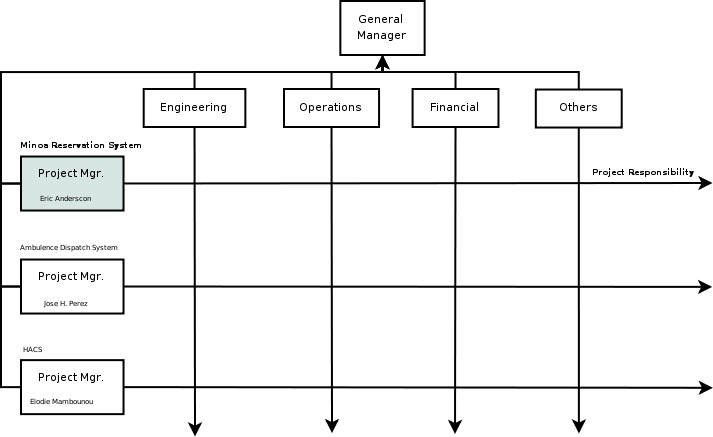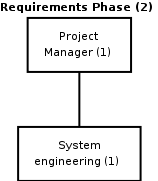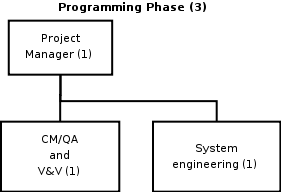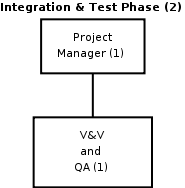Minoa's Reservation System
Project members:
Eric Anderson (Project Manager)
José Perez
Elodie Mambounou
Prathab Prabhakaran
Signature Page
Change History
| Version | Date | Comments |
|---|
| 1.0 | 2008-06-14 | Initial version; incomplete |
Preface
This Software Project Management Plan is intended to be followed to complete
the Minoa's Reservation System. The Minoa Travel Agency needs the Reservation
System to manage its three hotels: Minoa-A, Minoa-B, and Minoa-C. Please see
the Project Description for more information of the content of this document.
This document is intended for the Project Manager and his superiors to provide
the understanding and documentation of this project's organization and processes.
This document also provides members of the Project Team the processes that they
will follow to complete the project. In general, all individuals related to the
project are considered part of the intended audience. This document should also
provide information valuable to future Project Managers to improve Tech-9's
development processes.
Table of Contents
List of Figures
List of Tables
Overview
Project Summary
Purpose, scope and objectives
The Minoa's Reservation Project aims at developing a system to store and retrieve
information and conduct transactions related to prospective guests.
The Minoa's System will manage three hotels (Minoa-A, Minoa-B
and Minoa-C) situated in the the Santorini island in Greece. The system will
reside in those hotels and will interact with a database to store and get
information.
The objectives of this project is to develop a reservation system that will
- Generate the cost of a stay based on the time of the year and the type of reservation
- Retain prospective guests' reservations and card information
- Print three reports daily for management use
Assumptions and constraints
Assumptions:
- The project team would be assumed to not to change from the inception of the project unless an unavoidable situations is to arise.
- The project team members are expected to adhere to the project plan
- The project plan is susceptible to changes.
- The top management is expected to over see the progress of the project.
- Java is assumed to be the main development language used for this project
- There is a Trac server that would be running all the time.
Constraints:
- All communication, processes, etc., need to abide by the applicable national and international laws and regulations of the United States and Greece.
- The time zone difference between the client site and the development team is to be considered when deciding about meetings and schedules between the two parties.
Project deliverables
The deliverables of this project will be:
- Software Requirement Specification document
- Software Design Document
- Test Cases Document
- Result Test Cases Document
- Verification and Validation Document
- Quality Assurance Plan Document
Schedule and budget summary
| Deliverable |
Schedule |
Budget |
| Software Project Plan |
August 2, 2008 |
$300 mil |
| Requirements Specification |
September 22, 2008 |
$1 mil |
| Design |
March 31, 2009 |
$1 mil |
| Implementation |
June 1, 2009 |
$1 mil |
| Testing |
July 1, 2009 |
$1 mil |
| Software Release |
June 23, 2009 |
$1 mil |
Schedule and Budget Summary
Evolution of the plan
References
IEEE. IEEE std. 1058-1997 IEEE Standard for Software Project
Management Plans. Retrieved June 12, 2008, from IEEE web site:
http://standards.ieee.org/reading/ieee/std_public/description/se/1058-1998_desc.html
Definitions
- Software
- the computer programs in machine-readable
code form and any subsequent error corrections or updates supplied
to Sponsor by University.
- V&V (Verification and Validation)
- process of checking that a product, service,
or system meets specifications and that it fulfils its intended purpose
- CM (Configuration Management)
- focuses on establishing and maintaining consistency
of a product's performance
- QA (Quality and Assurance)
- set of planned and systematic actions necessary to
provide appropriate confidence that a product or service will satisfy the
requirements for quality.
- KDSI (Kilo Delivered Source Instruction)
- measure of a programmer's productivity or a project productivity
- FSP (Full-Time Equivalent Software Personnel)
- staffing unit. One unit is equivalent to one individual working with a standard,
full-time, 40-hour work-week.
Project Organization
External Interfaces
The Project Manager is the point of contact for maintaining liaison with
the client, conducting program reviews, coordinating and supporting meetings
and approving primary deliverables. The project Manager attends all meetings
and assurances the attendance of its managers
Internal Structure
The University is organized in a matrix structure. The Project Manager
will establish and approve a schedule showing major activities needed to
establish capability according to the requirements.

Internal Structure
Roles and Responsibilities
- Requirement Analysis Team
- Staff is responsible for determining, specifying, reviewing
and updating software functional, performance, interface and
verification requirements.
- Product Design Team
- Staff is responsible for determining, specifying, reviewing
and updating hardware-software architecture, program design and
data base design.
- Programming Team
- Staff is responsible for detailed desiging, coding,
unit testing and integrating individual computer program components.
- Test Planning Team
- Staff is responsible for specifying, reviewing and updating product
test and acceptance test plans.
-
- Verification and Validation Team
- Team is responsible for verifying and validating the code
- Project Office Functions Team
- Team's reponsibilities include project level planning and control,
contract and subcontract management, and customer interface
- Configuration Management and Quality Assurance Team
- Configuration Management's responsibilites include product integration, change control,
status accounting, operation of program support library, development
and monitoring of end item acceptance plan. Quality Assurance team's
responsibilities include development and monitoring of project standards,
and technical audits of software product and process
- Manuals Team
- Team is responsible for developing and updating user's manuals, operators'
manuals, and maintenance manuals
Managerial process plan
Start-up plan
Estimation plan
Staffing plan
Based on the requirements of this organic project, its estimated size
was 8 KDSI.
| Quantity | Plan & Requirement | Product Design | Programming | Integration and Testing |
|---|
| Effort | Percent | 6 | 16 | 65 | 19 |
| MM | 1.3 | 3.4 | 14 | 4 |
| Schedule | Percent | 11 | 19 | 59 | 22 |
| Month | 1 | 1.5 | 4.7 | 1.8 |
| Average and Number of Personnel | FSP | 1.3 | 2.3 | 3.0 | 2.2 |
Effort and Schedule
| Activity | Plans and Requirement | Product Design | Programming | Integration and Test |
|---|
| Percent | FSP | Percent | FSP | Percent | FSP | Percent | FSP |
| Requirement Analysis | 46 | 1.0 | 15 | 0.3 | 5 | 0.2 | 3 | 0.1 |
| Product Design | 20 | 0.3 | 40 | 1.0 | 10 | 0.3 | 6 | 0.1 |
| Programming | 3 | 0.03 | 14 | 0.3 | 58 | 1.7 | 34 | 0.7 |
| Test Planning | 3 | 0.03 | 5 | 0.1 | 4 | 0.1 | 2 | 0.04 |
| Verification and Validation | 6 | 0.1 | 6 | 0.1 | 6 | 0.2 | 34 | 0.7 |
| Project Office Function | 15 | 0.2 | 11 | 0.3 | 6 | 0.2 | 7 | 0.2 |
| CM/QA | 2 | 0.03 | 2 | 0.05 | 6 | 0.2 | 7 | 0.2 |
| Manuals | 5 | 0.1 | 7 | 0.2 | 5 | 0.2 | 7 | 0.2 |
Activity Distribution by Phase
Resource acquisition plan
Project staff training plan
Work plan
Work activities

Requirements Phase Organization

Programming Phase Organization

Integration Phase Organization
Schedule allocation
Resource allocation
Budget allocation
Control plan
Requirements control plan
Schedule control plan
Budget control plan
Quality control plan
Reporting plan
Metrics collection plan
Risk management plan
Closeout plan
Technical process plans
Process model

Software Process Overview
| Part | A0 |
|---|
| Entry | Written customer request |
| Exit | Tested software, documentation, deployment |
| Feedback In | Customer problem and request |
| Feedback Out | Software system |
| Task | Development of software system or decision not to. |
| Measures | Cost, time, KDSI, customer feedback |
Software Process Overview

Software Process A0
| Part | A1 | A2 | A3 | A4 |
|---|
| Entry | | | | |
| Exit | | | | |
| Feedback In | | | | |
| Feedback Out | | | | |
| Task | | | | |
| Measures | | | | |
Software Process A0

Software Process A1
| Part | A11 | A12 | A13 | A14 | A15 | A16 |
|---|
| Entry | | | | | | |
| Exit | | | | | | |
| Feedback In | | | | | | |
| Feedback Out | | | | | | |
| Task | | | | | | |
| Measures | | | | | | |
Software Process A1

Software Process A2
| Part | A21 | A22 | A23 | A24 |
|---|
| Entry | | | | |
| Exit | | | | |
| Feedback In | | | | |
| Feedback Out | | | | |
| Task | | | | |
| Measures | | | | |
Software Process A2

Software Process A3
| Part | A31 | A32 | A33 | A34 |
|---|
| Entry | | | | |
| Exit | | | | |
| Feedback In | | | | |
| Feedback Out | | | | |
| Task | | | | |
| Measures | | | | |
Software Process A3

Software Process A4
| Part | A41 | A42 |
|---|
| Entry | | |
| Exit | | |
| Feedback In | | |
| Feedback Out | | |
| Task | | |
| Measures | | |
Software Process A0
Methods, tools and techniques
Infrastructure plan
Product acceptance plan
Supporting process plans
Configuration management plan
Verification and validation plan
Documentation plan
Quality assurance plan
Reviews and audits
Problem resolution plan
Subcontractor management plan
Process Improvement plan
Additional plans
Annexes
Index









